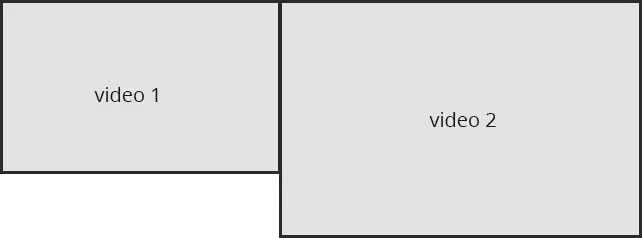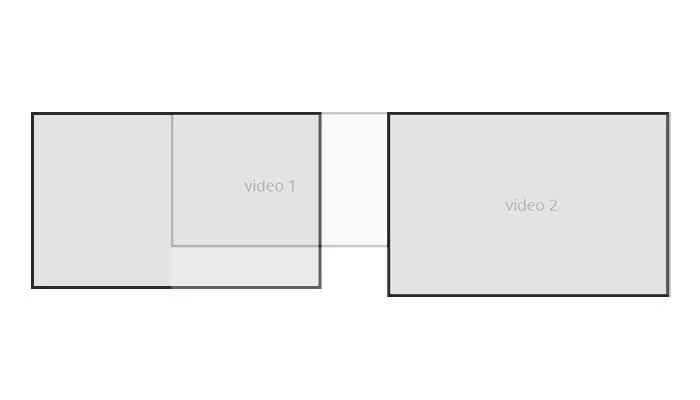我正在编写一段代码,可以从多个图像和多个视频在iOS设备上生成幻灯片演示视频。我已经能够使用单个视频和多个图像完成此操作,但我无法弄清如何将其改进为多个视频。
这里是我能够使用一个视频和两个图像生成的样本视频。
这是主要程序,用于准备出口商。
这里是_addVideo:time:方法,它创建了videoLayer。
这里是我能够使用一个视频和两个图像生成的样本视频。
这是主要程序,用于准备出口商。
// Prepare the temporary location to store generated video
NSURL * urlAsset = [NSURL fileURLWithPath:[StoryMaker tempFilePath:@"mov"]];
// Prepare composition and _exporter
AVMutableComposition *composition = [AVMutableComposition composition];
AVAssetExportSession* exporter = [[AVAssetExportSession alloc] initWithAsset:composition presetName:AVAssetExportPresetHighestQuality];
exporter.outputURL = urlAsset;
exporter.outputFileType = AVFileTypeQuickTimeMovie;
exporter.shouldOptimizeForNetworkUse = YES;
exporter.videoComposition = [self _addVideo:composition time:timeVideo];
这里是_addVideo:time:方法,它创建了videoLayer。
-(AVVideoComposition*) _addVideo:(AVMutableComposition*)composition time:(CMTime)timeVideo {
AVMutableVideoComposition* videoComposition = [AVMutableVideoComposition videoComposition];
videoComposition.renderSize = _sizeVideo;
videoComposition.frameDuration = CMTimeMake(1,30); // 30fps
AVMutableCompositionTrack *compositionVideoTrack = [composition addMutableTrackWithMediaType:AVMediaTypeVideo preferredTrackID:kCMPersistentTrackID_Invalid];
[compositionVideoTrack insertTimeRange:CMTimeRangeMake(kCMTimeZero,timeVideo) ofTrack:_baseVideoTrack atTime:kCMTimeZero error:nil];
// Prepare the parent layer
CALayer *parentLayer = [CALayer layer];
parentLayer.backgroundColor = [UIColor blackColor].CGColor;
parentLayer.frame = CGRectMake(0, 0, _sizeVideo.width, _sizeVideo.height);
// Prepare images parent layer
CALayer *imageParentLayer = [CALayer layer];
imageParentLayer.frame = CGRectMake(0, 0, _sizeVideo.width, _sizeVideo.height);
[parentLayer addSublayer:imageParentLayer];
// Specify the perspecrtive view
CATransform3D perspective = CATransform3DIdentity;
perspective.m34 = -1.0 / imageParentLayer.frame.size.height;
imageParentLayer.sublayerTransform = perspective;
// Animations
_beginTime = 1E-10;
_endTime = CMTimeGetSeconds(timeVideo);
CALayer* videoLayer = [self _addVideoLayer:imageParentLayer];
[self _addAnimations:imageParentLayer time:timeVideo];
videoComposition.animationTool = [AVVideoCompositionCoreAnimationTool videoCompositionCoreAnimationToolWithPostProcessingAsVideoLayer:videoLayer inLayer:parentLayer];
// Prepare the instruction
AVMutableVideoCompositionInstruction *instruction = [AVMutableVideoCompositionInstruction videoCompositionInstruction];
{
instruction.timeRange = CMTimeRangeMake(kCMTimeZero, timeVideo);
AVAssetTrack *videoTrack = [[composition tracksWithMediaType:AVMediaTypeVideo] objectAtIndex:0];
AVMutableVideoCompositionLayerInstruction* layerInstruction = [AVMutableVideoCompositionLayerInstruction videoCompositionLayerInstructionWithAssetTrack:videoTrack];
[layerInstruction setTransform:_baseVideoTrack.preferredTransform atTime:kCMTimeZero];
instruction.layerInstructions = @[layerInstruction];
}
videoComposition.instructions = @[instruction];
return videoComposition;
}
_addAnimation:time:方法添加图像层,并安排所有层的动画,包括_videoLayer。
到目前为止一切都工作正常。
然而,我无法弄清如何将第二个视频添加到此幻灯片演示文稿中。
AVFoundation编程指南中的示例使用多个视频合成指令(AVMutableVideoCompositionInstruction)将两个视频组合在一起,但它只是将它们渲染成一个CALayer对象,该对象在videoCompositionCoreAnimationToolWithPostProcessingAsVideoLayer:inLayer:方法(of AVVideoCompositionCoreAnimationTool)中指定。
我想将两个视频轨道渲染成两个独立的图层(layer1和layer2),并分别对它们进行动画处理,就像我正在处理与图像相关联的图层一样。


